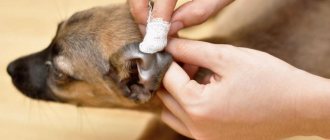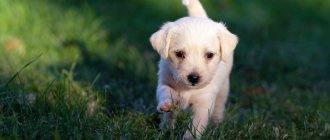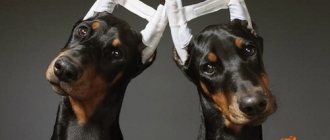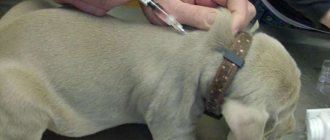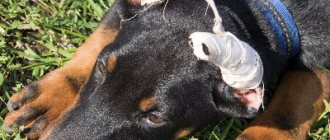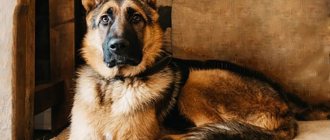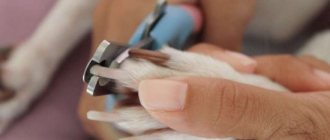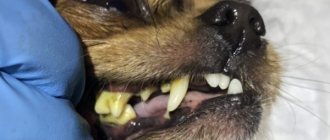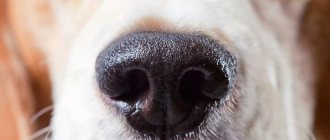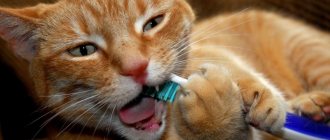Taking responsibility for the life of a four-legged friend, the owner understands that daily care will be required. At the same time, it is often overlooked that the pet’s oral cavity also requires care. If regular hygiene procedures are not performed, dogs can develop a number of dental problems accompanied by pain. Therefore, let's figure out how to properly brush your dog's teeth, what options are available and whether it can be done at home.
Getting used to the procedure at home
Dogs usually really do not like brushing their teeth and try to avoid the procedure by any means. Some pets hide and try to escape quickly, others try to scare the owner by snarling or, on the contrary, appeal for pity. But a dog accustomed to manipulation usually tolerates such a procedure without problems and behaves well.
For your information! Without trust and respect for the owner, the dog will not be able to perform well when brushing its teeth, since this procedure is extremely unpleasant for it. It is imperative to provide moral support to your pet and be patient while accustoming it to this hygienic procedure.
The sooner you start accustoming your puppy to brushing its teeth, the better and faster the results will come. Under no circumstances should you put moral pressure on your pet. If he is scared or in a bad mood, it is better to reschedule the training for the next time. But it is advisable not to delay the manipulation. It is important to show the puppy that the owner will never offend. Everything he does, even unpleasant procedures, is all for the benefit of the dog and you need to completely trust the person.
To achieve mutual understanding, you should never punish or frighten your pet. It is important to speak to him in a gentle, calm and confident tone, touch him gently, stroke him, and praise him. At the end of the procedure, be sure to reward - treat him with a tasty treat, play with his favorite toy.
We brush our dog's teeth twice a week
First you need to call the puppy. When he approaches, praise him. Carefully but securely fixing the dog, you need to lift its upper lip on one side, then on the other. Maintain this position for some time. After this, open your mouth and hold it in this position.
Feel your teeth and cheeks with your fingers. If the puppy starts to spin around and whine, you need to gently call his name, praise and encourage him. It is useful to stroke him; be sure to reward him for his efforts after such training is completed. It is important to associate unpleasant actions with positive emotions, gradually replacing them with a positive perception of the entire procedure. You can reinforce the manipulation with the voice command “teeth.” It is useful to repeat such training every day or at least every other day.
When the puppy is free to examine the oral cavity and does not feel constrained, you can proceed to the next stage, namely brushing your teeth. To begin with, wipe the teeth with a regular gauze swab moistened with plain clean water. Then, when the puppy gets used to this, you can use tools and dog toothpaste.
Useful tips
- Proper nutrition has a good effect on crowns, making them stronger and more resistant to rotting. Give the dog high-quality food, muscles, large cartilages. If your pet's crowns are loose, it is better not to give dogs a hard bone to clean their teeth.
- To clean, use a brush specially designed for pets.
- Never use human toothpaste, only buy product intended for dogs.
- Before the procedure, give your pet a sample of the toothpaste to try. The tasty smell will make him more accommodating.
- Encourage your dog with games, petting, and favorite activities to make him more accommodating and improve the cleaning process.
- If you are unable to remove plaque, purchase a dog treat or dental cleaning ball.
- When your pet quickly chews the teething stick, buy her a larger toy.
- If the animal has bad teeth, do not give hard toys.
Preparatory actions
Toothpaste is equally suitable for both large and small dogs.
First, you need to prepare the necessary tools, etc.:
- toothbrush;
- toothpaste for dogs;
- tweezers;
- napkins or towel;
- delicacy.
You need to call the dog and praise him. Let them smell the instruments that will be used to clean their teeth. Then place your pet in a bathtub, shower stall, or place it comfortably on a table, having previously laid out a towel.
You need to choose a place that is as convenient as possible for the owner and with close access to water.
The dog needs to be properly secured: you should hold it by the head with your left hand (with your right hand for left-handers), bending the upper lip near the nose, gradually moving closer to the cheeks as you brush your teeth. In the other hand, take a toothbrush (any type that is most convenient for the owner), after moistening it and applying a small amount of dog teeth cleaner. It is important to monitor your dog’s paws – you should not allow your pet to slide or be in an unstable position.
How to carry out
Using a prepared brush, using precise movements in the direction from the gums to the edge of the tooth, begin to clean the enamel. Start with the upper jaw. The first to clean are the incisors (the smallest teeth that are located in front, then the fangs, premolars (the teeth that grow behind the fangs), molars (the outer teeth that grow at the end of the dentition). Having completely processed the upper teeth, the same is done with the teeth of the lower jaw .
Toothpaste is added as needed. But you shouldn't use it too much. The same applies to other oral cleaning products.
Carefully! Only use products intended for animals. Under no circumstances should you use pastes, gels, or lotions for people. Otherwise, you can seriously harm your pet’s health, since the composition of such hygiene products varies greatly and human products are in no way suitable for animals.
If pieces of food, toys or other foreign objects are stuck between the teeth, they are carefully removed with tweezers. Pay attention to whether the object has damaged the gums. Minor damage can be left untouched - the mucous membranes of the oral cavity quickly recover on their own. But deep wounds need to be treated, so it is better to contact a veterinarian as soon as possible. When all the teeth have been brushed, the face is wiped with a clean towel or napkin. Representatives of bearded breeds, such as the Giant Schnauzer or the Italian Bolognese, have their chin hair washed and dried.
Washing a dog's eyes at home and what products are needed for this
In general, brushing your teeth takes 7 – 12 minutes. If, during this procedure, a usually calm dog behaves tensely, shows discomfort, and if the owner detects the following warning signs, then you need to take the dog to see a veterinarian:
- the plaque is dense and cannot be cleaned off;
- a yellow-brown, gray, brown stripe has appeared between the base of the tooth and the gum and cannot be cleaned off;
- gums are red and swollen;
- hypersalivation (excessive salivation);
- bleeding occurs during cleaning;
- a bad smell comes from the mouth.
It is also worth paying attention to the health of your four-legged friend if he eats poorly, is reluctant to play, or is depressed.
First aid
If the first signs of stomatitis appear, you should immediately take the animal to the veterinarian! Sanitation of the oral cavity in dogs by a specialist in such a situation is simply necessary. If for any reason this cannot be done, then the following procedures must be carried out:
- Carry out a careful inspection of the mouth. Pay special attention to any foreign objects lodged in the gum or cheek, such as bone debris or wood chips. If possible, carefully remove the found object with tweezers. If a foreign object is stuck deeply and it is difficult to remove it yourself, it is better not to torture the animal and go to a specialist;
- Wipe damaged mucous membranes with chamomile decoction, furatsilin, a weak manganese solution (0.1%) or 0.05% chlorhexidine solution. You can fill the spray bottle and spray the dog’s mouth cavity. Try not to hit the epicenter of the wound because this can increase the pain. It is better to lightly spray the surface around it. Instead of a spray bottle, you can use a cotton swab, but this is more painful. After carrying out the above procedures, do not let your pet drink or eat for about an hour;
- Hide for a while all your pet’s toys that he gnawed, sucked, or chewed. If the wounds are severe, the dog itself will not want to play with them. In a milder form, these squeaks and taffy can cause a worsening of the condition;
- It is necessary to exclude any cold, hot and hard foods. You can temporarily change your diet and switch to a soup diet, soft porridges, twisted meat or boiled fish, chopped eggs, grated vegetables. The food should be slightly warm.
What to do if your pet “grunts”
It happens that after rinsing the mouth, the dog grunts and snorts. This happens if a pet chokes on water (liquid gets into the respiratory tract and the dog tries to get rid of it by sharply pushing out air, which leads to such sounds). If a situation arises during cleaning, you need to stop and let your pet clear his throat. Only when the dog regains breathing can the procedure be continued, carefully monitoring the pet.
If your pet just can’t stop coughing and grunting, you can quickly and confidently slap him on the back in the area of the shoulder blades several times with your palm. The strength of the clapping must be controlled taking into account the size of the dog. The blow should be quite powerful, but safe. Small dogs and puppies just need to be patted with your fingers. With this technique, the pet is placed horizontally, with the head and front part of the body tilted down slightly.
Daily dental examination for your dog
Side effects
There are no contraindications to the use of gel or spray.
In rare cases, allergic reactions may occur during use due to individual intolerance to the components of the product. The gel can sometimes cause gagging. If unpleasant symptoms appear, treatment with the drug should be stopped and the mouth should be rinsed.
Both forms of Zubastic can lead to staining of the enamel. This is not a contraindication for use.
Age characteristics
The age of the dog directly affects the condition of the teeth, so it is important to take into account the age group of the pet and, based on this, apply the necessary cleaning techniques.
For puppies up to six months old, it is enough to wipe the teeth with a damp gauze swab or a small soft toothbrush. Pastes and other abrasives should not be used.
The procedure is carried out with extreme caution during the period of teeth change (from approximately 2–3 months to 6–12 months, depending on the breed and conditions of detention). Only when all the baby teeth have been replaced by permanent teeth can you start using cleaners and brushes with stiffer bristles.
Young adult dogs have their teeth brushed more often than puppies - every day or, if that doesn’t work, then once every two to three days, at least. It is important to take into account the pet's health status and the veterinarian's testimony, if any.
Elderly dogs are given special attention. Teeth gradually wear out and become brittle and damaged with age, and sensitivity increases. Therefore, they choose softer brushes and try not to touch the gums when cleaning. If your teeth have chips or cracks, you should treat such areas with extreme caution so as not to aggravate the situation. The number of cleanings can be reduced to 2–3 times a week. Regardless of the age and upbringing of your pet, it is important not to forget to support and praise it.
What products are used at home?
There are a wide variety of dog oral care products to choose from. Manufacturers offer many options in different price categories, so you can choose the right one for any pet. It is useful to consult with a veterinarian or a knowledgeable pet store sales consultant before making a choice.
Toothbrushes
A special toothbrush that fits on your finger.
They produce a lot of varieties of these important tools, taking into account the differences in size and structure of the jaws of different breeds of dogs. Brushes are: long, short, with a large and small surface covered with bristles, double-sided and single-sided.
They also produce brushes that fit onto the owner’s finger. You can choose different bristle hardness. Manufacturers offer cleaning, massage, and mixed brushes.
For older dogs with a long muzzle, brushes with a long handle or those that fit over your finger are best. For small dogs, it will be more convenient to use small brushes with short handles; the same brushes are used to clean the teeth of cats. If you use finger brushes, you should choose ones with short bristles and a small working surface. Prices depend on the type of tool and manufacturer: from 40 to 550 rubles. Brushes are also sold in specialized sets.
Liquid toothpaste for dogs
Liquid
A less common option for dog oral care products. It is a liquid that is mixed into your pet’s drinking water at the rate indicated on the package (approximately 1 teaspoon of product per glass of water).
A liquid toothbrush is more of a rinse for a dog’s mouth, odorless and tasteless, so pets can easily accept such an additive in water. A similar product is also available in the form of a spray, which is applied directly to the dog’s teeth and gums.
The product is well suited for freshening breath, removes bad odor, strengthens enamel, prevents, but does not clean plaque and, especially, tartar. The cost varies: from 100 to 800 rubles.
We wipe our teeth with a special napkin
Napkins
It is convenient to use ready-made moistened wipes to clean your teeth. They are used to wipe teeth and can be used every day. The composition with which the wipes are impregnated includes natural ingredients that have an anti-inflammatory and soothing, as well as a refreshing effect.
Napkins are convenient because they do not require preliminary preparation before use. The package should be tightly closed to prevent the contents from drying out. After use, the napkins are thrown away. Such dental care products are sold at a price of 400 – 800 rubles.
Toothpaste for dogs
Toothpaste
The main difference between human toothpaste and that intended for dogs is that toothpaste for animals does not foam and has a less pungent aroma and taste, which makes brushing your pet’s teeth comfortable.
They produce various options: with the aroma of refreshing mint, green tea, chamomile, or with the taste of bacon or turkey. Pet stores offer pastes from Trixie, Beafar, 8 in 1, Hartz.
There are no fundamental differences between toothpastes for dogs. Any toothpaste fights plaque, which prevents the appearance of tartar. The only difference between the options is the aroma left after using such a product. The owner is free to choose what suits his pet better - fresh mint or delicious bacon. You can buy toothpaste for dogs at a price starting from 120 rubles. up to 400 rub.
Dog teeth cleaning gel
Gel
This is an effective tool for cleaning teeth from plaque, removing tartar and whitening tooth enamel.
Despite the similarity in the form of the gel and the paste, this product is used a little differently: a small amount of the gel in the form of a thin strip is applied to the border of the tooth and gums and left for about 10 - 15 seconds for the composition to take effect.
Then, if desired, you can use any type of toothbrush to clean off the gel along with the stains on the teeth with confident movements in the direction from the gums to the tip of the tooth. However, the gel can be used without subsequent mechanical teeth cleaning. You can usually find orozyme gel or tropicline in veterinary pharmacies and pet stores. Price category in the region from 800 rubles. up to 1300 rub.
Specialized spray for cleaning teeth
Spray
This is a convenient product for caring for the oral cavity, as it instantly freshens your pet’s breath, is easy to use and does not require additional treatments. However, the spray does not remove tartar and does not fight plaque well. The product is produced in bottles of various sizes; you can purchase it at a price of 90 – 900 rubles.
Dental lotion specifically for dogs
Lotions, rinses, emulsions
Liquids for caring for the dog’s oral cavity, having different compositions, but similar effects and procedures for use. Such products can be used every day and combined with mechanical teeth cleaning. Rinse the dog's mouth with lotion and wash the teeth and gums. No subsequent rinsing with water is required.
Lotions, rinses, emulsions and other similar products are not suitable as the main hygienic means for caring for the dog’s oral cavity, but they are very convenient to use as additional auxiliary breath fresheners for the dog. Prices for liquid dental products vary: from 80 rubles. up to 1200 rubles, depending on the manufacturer, the composition of the product, and the volume of the bottle.
Special treats that dogs love that clean their teeth
Specialized treats
Many dog treats help remove plaque and prevent tartar buildup.
These include hard rough sticks (Trixie, Beafar, 8 in 1 and other brands), dry meat medallions, hard dog biscuits, as well as specially prepared dried, smoked and calcined cartilage. During chewing, such treats mechanically remove deposits on the teeth.
Sticks and bones
Pets really like these kinds of treats and can be given every day. These treats are also suitable for training as a healthy reward. Dental sticks and bones are sold both individually and in packages. They produce various flavors and their combinations: beef, turkey, chicken, fish, cereals and others. Manufacturers take into account the age and size of the dog. Teeth cleaning treats often include a vitamin complex. You can purchase similar treats for your four-legged friend at prices ranging from 7 – 10 rubles. up to 200 rub. per piece, if you choose in packages, the cost depends on the number and size of the treats.
Any bowl will do, even a regular plastic one.
Dry food
Manufacturers of premium and super-premium dog food also produce food for pet dental care. The special shape of the crickets, density and composition, when fed daily, mechanically affects tooth enamel and removes plaque, preventing the formation of tartar.
The required volume is indicated on the package based on the dog's weight. Manufacturers indicate different prices: from 300 rubles. up to 1200 rub. per kilogram of feed.
Any bowl is suitable for feeding, even the most budget option - plastic.
Special toys for dogs that clean teeth from plaque
Toys
Don't neglect special toys for dogs. Many companies produce rubber, caoutchouc and silicone sticks, balls, discs and other toys for pets, not only as entertainment for them, but also for oral care.
Firstly, such dense, lumpy and rough toys attract pets, stimulate their physical and mental activity, and secondly, the uneven chewing surface affects tooth enamel and removes plaque, improves blood flow to the gums.
Prices are very varied: from 50 rubles. up to several hundred rubles.
Advice! It is useful to periodically visit the veterinary office and carry out an examination and, if necessary, a full professional teeth cleaning, using instruments, ultrasound and other medical devices.
Some owners have doubts about the use of hydrogen peroxide and chlorhexidine. In veterinary medicine, similar drugs are sometimes used to treat oral diseases in dogs. However, such medications are not suitable for hygienic treatment. Using these liquid dosage forms can, on the contrary, harm your pet, which subsequently leads to the need for treatment. A non-professional should not prescribe medications on their own; it is wiser to use ready-made professional products for cleaning dogs’ teeth.
Tartar on teeth in dogs, treatment methods
One of the main reasons for the occurrence of a repulsive odor from the oral cavity in dogs is the appearance of tartar. It has a finely porous structure and is formed as a result of the accumulation of brown or greenish-gray plaque mixed with minerals and saliva. If you notice that your pet's teeth have become very yellow and there is a stench from the mouth, then you should brush your dog's teeth to remove tartar.
Today in practicing medicine there are two methods for removing tartar in dogs.
The first method, mechanical, is implemented using special tools. The veterinarian dentist independently, manually, cleans the fangs and molars of tartar. The procedure may cause side effects in the form of malaise and discomfort. Various complications may also arise.
The second method is implemented using ultrasonic equipment. This method is more effective as it allows you to remove tartar quickly and without pain. At the end of the procedure, a special dental paste is applied to the teeth to protect the tooth enamel. It temporarily stops the process of occurrence and formation of tartar.
Care after tooth extraction
Separately, we should consider the situation when a pet loses a tooth. If this is due to the age-related change of teeth (from baby teeth to permanent ones), then during this period it is important not to overstrain the pet’s oral apparatus and not to overdo it with brushing. If a permanent tooth had to be removed in a clinical setting for a number of reasons, careful postoperative care for the dog is very important so that recovery is as quick and painless as possible.
During this period, it is better not to disturb your pet again. The dog is not fed for the first 3 - 4 hours after tooth extraction; after this time, you can give gentle porridges or broths so that the dog does not have to chew a lot. Solid treats are excluded, toys should be removed.
What care is required for dogs' claws and paws in summer and winter, as well as what tools will be needed
The recovery process takes about a week, but can take longer. It all depends on the reason why it was indicated to remove the tooth, on the placement of the tooth in the oral cavity, on the dog’s health, the professionalism of the veterinarian and the conditions of detention.
The first day you need to provide the dog with rest, during this period a clot is formed that closes the hole from the extracted tooth and ensures further healing of the wound. In the following days, the dog is fed with easily chewable food and exercise is reduced.
It is necessary to strictly follow the instructions of the treating veterinarian. Mouth rinses with various medications are often prescribed a certain number of times a day. Do not neglect such advice, and your pet will quickly recover from tooth loss.
For your information! Modern veterinary medicine provides the possibility of dental prosthetics for dogs. If desired or necessary, you can install an artificial tooth for your pet, which is organic and comfortable for pets.
During the recovery period, teeth are not brushed so as not to damage the wound. If an implant is installed, then after healing the artificial tooth is cared for in the same way as other teeth.
Disease Prevention
This toothbrush is good because it can be put on your finger, or you don’t have to put it on.
In addition to the aesthetic value - removing unpleasant odor from the mouth, whitening teeth, caring for the pet’s oral cavity is also important for its health. Keeping teeth clean is important for the prevention of oral diseases - caries, pulpitis, gingivitis, ulcers of the mucous membranes and many other diseases.
A dog whose oral cavity has been taken care of since childhood remains healthy longer into adulthood and loses less teeth in old age. In addition, the risk of diseases of the stomach and intestines is reduced, since digestion begins directly in the oral cavity and depends on the condition of the teeth - all organs of the gastrointestinal tract are interconnected and affect the general condition of the body.
Pathogenesis
Precipitated mineral salts are gradually deposited on the yellowish soft coating. Initially loose, the formations harden and darken. The gums swell, bleed, and hurt. It becomes difficult for the dog to grind food with its teeth. Stomatitis, abscesses occur, teeth fall out or require removal.
From the source of inflammation, pathogenic microflora is introduced into the internal organs, causing diseases of the stomach, intestines and kidneys. In severe situations, sepsis develops, ending in the death of the pet.
